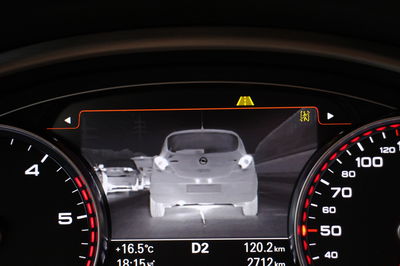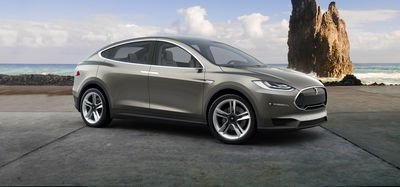6 Mind-Blowing Car Technologies That'll Be Everywhere In 10 Years

1. Infrared 'night-vision' cameras

In case you go to bed really early and wake up really late, or live in one of those countries where the sun never sets, you might not know this, but the problem with night-time is it’s pretty difficult to see. That’s why we have headlights to illuminate what’s in front of the driver, but although effective, the fact that you’ll struggle to seeing anything outside of the beam is a bit of an issue.
More and more manufacturers are turning to LEDs and, in the case of the new Audi R8, frickin’ laser beams, but we reckon the most intriguing way to light up the night ahead of you is through night vision, which can be seen in action in a Mercedes S-class below. The way it works is by using a thermographic camera, which relays the heat signature of objects ahead of the car.
If you skip to 1min 50sec in the video above, you can see how advantageous these systems can be. It detects pedestrians by the side of the street, and the cat running in front of the car is clearly lit. Current technology limits manufacturers to choosing between short range and high resolution, or long range and lower resolution. They can also struggle to work in rain, fog, and hot weather.
With safety technology at the forefront of many manufacturers’ minds, it’d be no surprise to see night vision technology advance quickly, before trickling down into normal cars. It’ll be interesting to see whether head-up displays advance to the point where the infrared image can be displayed ahead of the driver - or through wearable technology like Google Glass - as having to look down at a screen isn’t ideal.
2. Autonomous vehicle technology

One of the biggest fears petrolheads face in the future probably comes in the form of autonomous vehicle technology. We’re a long way from Minority Report-esque highways, where AI-controlled pods scoot about of their own accord, but that’s mostly due to legislature hold ups. In reality, most of the technology required for a car to drive itself is already available.
Automatic braking technology is slowly making its way down from expensive SUVs to more humdrum family motors, so expect that to be standard in all but the most budget hatchbacks in a few years. Other autonomous technology that’s quickly making its way into normal cars includes adaptive cruise control and lane assist functions combining to make cruising on the motorway easy, inner-city start-stop traffic assists allowing you to crawl to work without touching the pedals, and automatic parking meaning you don’t even need to be capable of putting the car in a bay once you reach your destination.
The basic principles of how engines work haven’t really changed for a very, very long time. If you think about all the incredible advancements we’ve made with the internal combustion engine, it’s kind of surprising that no one has really come up with a better alternative.
Well, legendary innovator Christian von Koenigsegg is actually working on an alternative, using a free valve actuator. I urge you to watch the video as it’s genuinely fascinating, but in an attempt to put it simply, the engine does away with the camshaft, with each valve controlled individually. This allows the combustion process to run far more efficiently, and can be tweaked for performance and economy far easier. Other benefits include the fact that the engines then become cheaper to produce, and much smaller and lighter.
Von Koenigsegg told us that his company could branch out into ‘normal’ cars in the future, so free valve engines would likely be at the forefront of this. With ever more stringent economy targets for manufacturers, free valve engines could be a huge deal.
4. Long-range EVs

Ask any of the anti-EV brigade what their biggest complaint about electric cars is, and it’s usually range. The average UK car journey is approximately eight miles, so for most people it’s not really an issue, but what if your mum lives 300 miles away and she calls you in urgent need of your help? It’s a legitimate worry, and it’s the biggest hurdle electric cars have to jump right now.
Tesla is far ahead of the game on this, with a theoretical range in excess of 250 miles, and the forthcoming Chevrolet Bolt will have almost as long a range. 10 years down the road, more efficient batteries, faster charging and better charging infrastructure will mean we’ll look back at the double digit range of many of today’s ‘leccy cars and laugh. It’ll likely be normal for EV owners to head off on 1000-mile road trips without a second thought.
5. Carbonfibre, carbonfibre everywhere

Saving weight is paramount to creating a great car. Whether you want to save MPG or accumulate MPH, the less the car weighs, the easier that becomes. Manufacturers have always been keen to introduce the next generation of sturdy, lightweight material; in the 90s the Honda NSX pioneered using aluminium instead of steel, and today carbonfibre appears to be the new lightweight material of choice.
Once the preserve of exotic performance cars, BMW has become the first manufacturer to use carbonfibre in large-scale car production in its i3 and i8 models. The German manufacturer actually uses recycled carbonfibre made from off-cuts and trimmings that’d normally go to waste, just like Zenos uses in its E10 sports car; it’s about 70 per cent as strong as ‘virgin’ CF, is nearly as light, but most importantly, can be made for just a tenth of the price.
Ultimately, you can expect to see more and more non-exotic cars adopting the material as manufacturing costs drop - the Alfa Romeo Giulia will have a carbonfibre propshaft even in its most basic models, for example.
6. Integration with exterior technology

In an age of smartphones and wearable technology, it’s no surprise to see more and more manufacturers creating apps that allow you to interact with your car. To use Tesla as an example, again, you can download an app for your phone that lets you keep an eye on your charge state, turn on the climate control before you get in, and even use your phone in place of the key.
Apple CarPlay and Android Auto, the car operating systems from the mobile phone juggernauts, further blur the distinction between where your phone ends and your car begins. With manufacturers signing up for these systems in place of their own, even cheap and cheerful runabouts could have integrated app connectivity. It’s not hard to imagine sending your car off to park somewhere nearby, then using your phone to call it back to you when you want to go home.
With the likes of Hyundai BlueLink showing manufacturers are already jumping on this bandwagon, all it needs is for wearable technology to become more affordable for this to be commonplace.













Comments
No comments found.